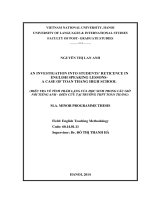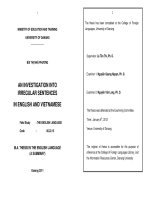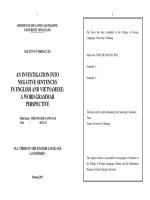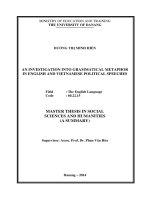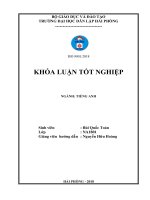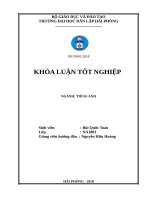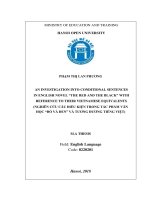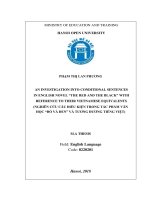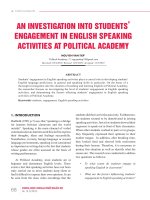AN INVESTIGATION INTO WAR METAPHORS IN ARTICLES ABOUT THE VIETNAM WAR FROM 1954 TO 1975 IN ENGLISH AND VIETNAMESE
Bạn đang xem bản rút gọn của tài liệu. Xem và tải ngay bản đầy đủ của tài liệu tại đây (218.72 KB, 26 trang )
MINISTRY OF EDUCATION AND TRAINING
THE UNIVERSITY OF DANANG
ĐỖ THỊ KIM CHUNG
AN INVESTIGATION INTO WAR METAPHORS IN
ARTICLES ABOUT THE VIETNAM WAR FROM
1954 TO 1975 IN ENGLISH AND VIETNAMESE
Field
: THE ENGLISH LANGUAGE
Code
:
60.22.15
MASTER THESIS IN SOCIAL SCIENCES AND HUMANITIES
(SUMMARY)
Supervisor: TRẦN QUANG HẢI, Ph.D.
Đà Nẵng, 2014
The thesis has been completed at the University of Foreign Language
Studies, University of Danang.
Supervisor: Trần Quang Hải, Ph. D.
Examiner 1: Assoc. Prof. Dr. Lê Phạm Hoài Hương
Examiner 2: Lê Tấn Thi, Ph. D.
The thesis to be orally defended at Examining Committee.
Time: December 13th, 2014
Venue: Danang University
The original of this thesis is accessible for purpose of reference at the
University of Foreign Language Studies Library, University of
Danang and the Information Resources Centre, Danang University.
1
CHAPTER 1
INTRODUCTION
1.1. RATIONALE
Metaphor plays a very significant role in human thought,
because metaphor is one of the most popular types of figures of
speech that are employed in nearly every linguistic aspect and it is
used effortlessly by most of people. Especially, conceptual
metaphors are seen in language in our everyday lives. Conceptual
metaphors shape not only our communication, but also the way we
think and act. In Lakoff and Johnson’s work, Metaphor We Live By
(1980), they claim that we see how everyday language is filled with
metaphors we may not always notice. Conceptual metaphors are used
very often to understand theories and models. A conceptual metaphor
uses one ideal and links it to another to have better understand
something.
Together with the development of Cognitive Linguistics (CL),
a variety of studies on metaphors in general and cognitive metaphors
(CMs) have been done. However, until now, researchers on cognitive
metaphor regarding war metaphors in articles about the Vn W (Vn
W) have been left unexploited. Cognitive metaphor is used a lot in
articles about war to expose the atrocities of invaders to help every
body in the world can see the ruthlessness of war.
Let us consider the following examples:
(1) The same day that Hamburger Hill was finally captured,
Senator Edward Kennedy of Massachusetts called the operation
"senseless and irresponsible" and attacked the military tactics of
President Richard Nixon's administration.
[90]
2
(2) Giặc Mỹ thất điên bát đảo trước những đòn đánh thông
minh và bất ngờ của các chị.
[130]
(3) Vô vọng trong việc thực hiện mục tiêu, hoang mang vì
phải đối mặt với một lực lượng thoắt ẩn, thoắt hiện giữa trùng điệp
núi rừng, lính Mỹ trở nên hung hãn, cuồng loạn.
[145]
As can be seen from the mention of above examples, we can
figure out that War is madness that can be realized through words
denoting madness such as: thất điên bát đảo, cuồn loạn, senseless
loss. The source domain (SD) of the metaphor is madness and the
target domain (TD) is war. The cognitive metaphor that can be
recognized in the examples above is War is madness. Although Viet
Nam war receded, the sorrow of war remains until now. Each of us
needs to look back the past to keep the peace. There for, articles
about war have been paid attention by lots of people and this will be
a good research opportunity to have an insight look into this field to
explore the varied uses of metaphor. Moreover, these articles will be
an invaluable source of reference for metaphor study. Yet, in just a
thesis, to cover all of articles about war is too wide. Hence, I will
choose an investigation into war metaphors in a narrow scope “An
Investigation into war metaphors in Articles about the Vn W
from 1954 to 1975 in English and Vietnamese”. I hope that my
study will help readers, teachers, learners and translators use English
and Vietnamese metaphor more correctly and use language more
effectively.
1.2. AIMS AND OBJECTIVES
1.2.1. Aims
This research aims:
3
· To identify the CMs denoting the concept of war in articles
about the Vietnam war (Vn W) from 1954 to 1975 in English and
Vietnamese.
· To examine how the CMs are used to express the concept of
war.
· To find out the similarities and differences in CMs of war in
articles about the Vn W from 1954 to 1975 in English and
Vietnamese.
1.2.2. Objectives
The study is intended to fulfill the following objectives:
· To investigate the CMs denoting the concept of War in
articles about Vn W from 1954 to 1975 in English and Vietnamese.
· To categorize the CMs of War in articles about Vn W from
1954 to 1975 in English and Vietnamese.
· To analyze and discuss the CMs of War in terms of meaning,
structure, mapping.
· To discover the similarities and differences of CMs denoting
the concept of War in articles about Vn W from 1954 to 1975 in
English and Vietnamese.
· To suggest some implications for foreign language teaching,
learning, and translation studies.
1.3. RESEARCH QUESTIONS
In order to fulfill the objectives above, the study attempts to
give answers to the following questions:
1. How are the CMs of War conceptualized in articles about Vn
W from 1954 to 1975 in English and Vietnamese?
4
2. What are the similarities and differences of CMs denoting
the concept of War in articles about Vn W from 1954 to
1975 in English and Vietnamese?
3. What are the possible implications for the use of CMs of
War in English language teaching, learning and translating
from English into Vietnamese and vice versa?
1.4. SCOPE OF THE STUDY
1.5. SIGNIFICANCE OF THE STUDY
- Introduce to the readers the CMs denoting the concept of
War and the ways they are created with their metaphorical mappings.
- The finding out the similarities and differences of the
metaphorical expressions of War in articles about the Vn W from
1954 to 1975 in English and Vietnamese.
- Provide a valuable source of reference to learners,
translators and researchers who have the same interest in studying
metaphors.
1.6. ORGANIZATION OF THE STUDY
5
CHAPTER 2
LITERATURE REVIEW
AND THEORETICAL BACKGROUND
2.1. LITERATURE REVIEW
2.2. THEORETICAL BACKGROUND
2.2.1. Definition of Metaphor
a. Definition of Traditional Metaphor
b. Metaphor in Cognitive Linguistics
2.2.2. Classification of Cognitive Metaphors (CMs)
a. Structural Metaphor
b. Ontological Metaphor
c. Orientation Metaphor
2.2.3. Metaphorical Mappings
a. Mapping Principles
· Source Domain
· Target Domain
· Mapping
b. Image Schemas
2.3 SUMMARY
6
CHAPTER 3
RESEARCH DESIGN AND METHODOLOGY
3.1. RESEARCH DESIGN AND METHODOLOGY
3.2. RESEARCH PARTICIPANTS
3.3. SAMPLING
3.4. RESEARCH INSTRUMENTS
3.4.1. The Questionnaires
3.4.2. Interviews
3.5. RESEARCH PROCEDURE
Ÿ Categorizing the collected data about CMs denoting the
concept of War in articles about Viet Nam War form 1954 to 1975
into two sub-categories.
Ÿ Analyzing and comparing CMs of War in the two languages.
Ÿ Finding out the similarities and differences in CMs of War
in English versus Vietnamese in articles about Vn W form 1954 to
1975.
3.6. VALIDITY AND RELIABILITY
7
CHAPTER 4
FINDINGS AND DISCUSSIONS
4.1.
RESULTS
FROM
THE
QUESTIONNAIRE
AND
INTERVIEW
4.1.1. With Yes/ No Questions
4.1.2. With Multiple-choice questions
As we see in the Questionnair items and the Interview items,
the number of students who understand CM is more than those who
do not know it (86.9% students in the questionnaires and 100%
student in the interviews). This number demonstrates that the M.A.
candidates are very interested in studying CM. However, the number
of students who does not know the concept of CMs still exists
(13.1% in the questionnaire). This figure makes us need to think of
the reason why and how to find the solution for these students (Q1 &
I1, Table1).
With the second question in the Questionnaire and the
Interview (Q2 & I2, Table2), there are 88.4 % of them stating that all
of definitions describe CM. Besides, 2.9 % out of students think that
CM refers to the understanding of one idea, or conceptual domain, in
terms of another. The definition of CM that is the regularity with
different languages employed the same metaphor, often appeared to
be perceptually based, led to the hypothesis that the mapping
between conceptual domains corresponded to neural mappings in the
brain is agreed with 5.8 %. Another 2.9 % reveals that a conceptual
domain can be any coherent organization of human experience. In
addition, the result from the interview is that all students (100 %)
think CM is the combination of A, B and C definitions.
8
Specifically, the result from the questionnaire (Q3&I3, Table
2) proves that CM occurs mostly in poet (37.5 %) following by
music (25 %), literature (30,2 %) and lastly in newspaper (7.2%). In
the interview, there are (40 %) students think that the frequent
occurrence of CM is in poem. The rest is equal in music, literature
and newspaper (20 %). This means that although it is not a lot,
newspapers are also one of the fields CM is used to convey many
meaningful messages.
The fact that most of people like reading newspapers but each
person likes different kind of newspapers. The result from the
questionnaire (Q4 & I4, Table2) reveals that women newspaper
account for (25%), police newspapers (30.2%), economic newspaper
(7.3%), and articles about war (37.5%). Meanwhile, in the interview
we can see that all of the students usually read articles about war.
We see that when students were asked about the definition of
articles about Vn W from 1954 to 1975 in (Q5 & I5, Table 2), most
of them choose the answer D.
It is clear that through above results, I think students will have
right recognition about CMs in the article about war.
In the section of Yes-No Question, regarding the question
items from 6 to 8, the percentages for “Yes” answers are from 92.7%
to 95.7%, while there are some students answering “No” in the
questionnaire (Q6, Table 1) 7.3%, (Q7, Table 1) 8.7%, (Q8, Table 1)
4.3%. In the interview, most of them agree 100%. Based on above
figures, this demonstrates that the students have a lot of sympathy of
the author’s view on the CM denoting the concept of “War is evil”.
(Q6&I6; Q7&7; Q8&I8, Table 1).
9
The responses in the questionnaire and interviews with student
show that the percentage of students who agree to the view of “War
is a substance in a container” from question 9 to question 10 is high.
The majority of them (100%) say “yes” in the process of interview.
In the questionnaire, one after another the percentages of “yes
answer” are 88.4%, 86.9%. It shows that students agree with the
author (Q9 & I10; Table 1).
The percentages of “yes answers” in the questionnaire from
the question items 11 to the question items 14 are 86.9%, 85.5%,
88.4%, 91.3%. These figures are very high. Besides, these
percentages revealed in the interview are very high too (100%, 80%,
100%, 80%). Therefore, we can understand that students agree with
the author CMs “War is a hunt” (Q11&I11; Q12&I12; Q13&I13;
Q14&I14; Table 1).
The responses in the questionnaire and interviews with
students show that the 100% students are unanimous in the view
“War is negative emotion” in the question item 15 & 16(Q15 & I15,
Q16&I16; Table 1).
In the questionnaire, the percentages supporting the view of
“War is death” in Q17& Q18 occupy 91.3% and 94.2% respectively.
In the interview, 100% assume that the view of “War is death”
occurs in all articles about the Vn W from 1954 t0 1975(Q17&I17;
Q18&I18; Table 1). When being interviewed in Questionnaire 18
&19, students state that they agree with 94.2% about concept “War is
parts of human body” and 100% in interview (Q19 & I19; Q20 &
I20; Table 1).
The concept which is “War is fire” is presented in
Questionnaire Q21 & I21; Q22 & I22 is supported by 91.3% &
10
88.4% students and 80% in interview (Q21 & I21; Q22 & I22; Table
1) It is positive to see all students realize the CM denoting “War is
disease” when being interviewed (100%). The rate is also high when
the students were asked in the questionnaire (88.4 % and 91.3%)
(Q23&I23; Q24&I24; Table 1)
The percentages support for “War is storm” are quite high in
the questionnaire. There are 82.6% and 100% for the Q25& Q26. In
the interview, there are 80% and 100% (Q25&I25;Q26&I26;Table1).
Responses from the questionnaire proving that many students
think that “War is business” occurs in Q27 & Q28 (91.3%, 94.2%,
respectively). The responses also reveal in the interview that 100%
agreeing in Q27& 80% say yes for question item 28 (Q27&I27;
Q28&I28; Table 1).
With question item 29, there is 94.2 % students doing
questionnaire and 80% doing interview realize the CM denoting
“War is cover” (Q29&I29; Table 1).
In question 30, 100% student when being asked in
questionnaire and 100% student when being interviewed they assume
that there is CM denoting “War is brave actions” (Q30&I30; Table
1). In question 31, 5.8% student when being asked in questionnaire
and 0% student when being interviewed assume that there is no CM
denoting War in “War is hatred” (Q31&I31; Table 1).
Especially, questions from 32 to 35, all the students think that
comprehending CM will help them in many fields such as
developing reading skill, improving translating and interpreting
skills, as well as bettering communicating skills (Q32 &I32; Q33 &
I33; Q34&I34; Q35& I35; Table 1).
11
4.2. COGNITIVE METAPHORS EXPRESSING WAR IN
ARTICLES ABOUT THE VIETNAM WAR FROM 1954 TO
1975 IN ENGLISH AND VIETNAMESE
4.2.1. War is Evil
We cannot deny the fact that “War is evil”. Because in any
wars and war occur in any places, firing, killing, destroying, ruining,
slaughtering… are main actions in a fight, they causes death, loss,
pain and other bad things. Especially, in the Vn W, American
soldiers’ barbarities are expressed clearly based on the examples. Let
us consider following examples to have an overview of this cognitive
metaphor “war is evil”.
(4.1) Elsewhere in the village, other atrocities were in
progress. Women were gang raped; Vietnamese who had bowed to
greet the Americans were beaten with fists and tortured, clubbed
with
rifle
butts
and
stabbed
with
bayonets.
[1]
(4.16) Trận càn quét trong vòng 1 giờ ngày 25/9/1969 tại ấp 5,
xã Thạch Phong, Thạch Phú, Bến Tre, quân Mỹ đã cắt cổ ông Bùi
Văn Vát và bà Bùi Thị Cảnh rồi kéo 3 em bé là cháu nội của ông bà
đang ẩn nấp tại ống cống, đâm chết 2 cháu, mổ bụng 1 cháu. Sau
đó, quân lực Mỹ di chuyển đến hầm trú ẩn của gia đình khác giết
chết 15 người, trong đó có 3 phụ nữ mang thai.
[105]
Table 4.3. CMs expressing War: War is evil
Target domain
Source domain
War
Evil
Cause of war
Evil seed
People who launch a war
People who cause evil
Actions taken in the fight
Actions cause evil
12
Consequence of a war
End of the war
Consequence of evil
End of the evil
4.2.2. War is a Hunt
We can see that there are many actions that are used in war
and hunting is the same so the metaphor of “War is a hunt” is shown
in many articles about the Vn W. We can find out this due to verbs
such as seek and destroy, hunt out, hunt down and a series of
above verbs used in the following examples demonstrate clearly the
metaphor “War is a hunt”
(4.32) 1st Cavalry Division, Colonel Thomas Brown, was
instructed to move from Pleiku to seek and destroy the enemy. [19]
(4.36) Hồ sơ cho thấy các nhà điều tra Mỹ đã phỏng vấn 137
nhân chứng và săn lùng dấu vết của các cựu thành viên.Tiger Force
ở 60 thành phố trên toàn thế giới.
[121]
Table 4.4. CMs expressing War: War is a hunt
Target domain
Source domain
War
A hunt
People who launch in war
People who launch in a hunt
Soldiers
Animals
Search the enemy
Search the decoy
Kill the enemy
Kill the decoy
War is over
A hunt stops
4.2.3. War is Negative Emotion
We find that negative emotion was one of the states of
emotion in war. Negative emotion was portrayed through fire and
sword, massacres etc happened everyday in war-time. This truth
helps us find out the interrelationship in the metaphor “war is
negative emotion”.
13
In the face of Death, nobody can control his emotion although
what citizen you are, Vietnamese or American people. Americans
burst in to tears when they stood in front of the Vietnam Veterans
Memorial in Washington, D.C that is the consequence of Vn W.
(4.42) I was moved to tears as encountered the names of
more than 58,000 of my fellow Americans etched in stone.
[23]
Table 4.5. CMs expressing War: War is negative emotions
Target domain
Source domain
War
Negative emotions occurs
Beginning a war
Negative emotion is expressed
Buồn (sad), khóc (cry), xót xa (tormented),
nước mắt (tears), nhọc nhằn (fatigue), rưng
People’s pain and rức (bitterly), nghẹn ngào (so choked with
suffering in war
emotion that can hardly say anything), buồn
teo (extremely sad), đau (painful), day dứt
(harassing)
Consequence of war
Negative emotion exists forever
4.2.4. War is Death
We cannot deny the fact that war that is the most frightful
thing of mankind always causing heart-breaking, death for
humankind. It is a judgment that does not need a verdict of the court.
In order to have general overview about the relationship between war
and death we should see the following examples.
(4.70) Instead of admitting to a war that should have never
been entered into, he kept troops over in Vietnam and many more
lives were lost.
[44]
14
Table 4.6. CMs expressing War: War is death
Target domain
Source domain
War
Death
Begin a fight
Begin deaths
Weapons were used in war
Murder weapons caused deaths
Violent battles happened in war
Series of deaths happened in war
Consequence of a war
Stop war
Fell, died, dead, buried, deaths,
more lives were lost
Stop death
4.2.5. War is Parts of Human Body
Obviously, we cannot ward off the truth that war is loss. Loss
of youth, love, family, life, money, and more heart - breaking that is
loss of a part of a whole body. Human beings who incur those losses
are soldiers at front. Although they are American soldiers or
Vietnamese soldiers, they cannot avoid that consequence. There for
the cognitive metaphor “war is parts of human body” springs from
that true. Let us look at following examples to understand clearly.
(4.90) During this fighting, the two platoon leaders were
wounded, Lieutenant Casper in the leg and Lieutenant Jones in the
foot.
[51]
Table 4.7. CMs expressing War: War is parts of human body
Target domain
War
People who are wounded
in war
Attack positions in a war
Source domain
Parts of human body
Parts of human’s body (hand, limb,
face, soul, eye, mouth, blood, body,
heart, foot)
Nose, back, armpit, slope, pharynx
15
4.2.6. War is Fire
It became clearly that in the event of a war, fire was the
symbol of fierce ruin in war, fire associates with lethal weapons.
Hence, fire was expressed a lots in articles about war both English
and Vietnamese languages.
(4.107) As dawn broke on February 1, it was deathly quiet.
The village of Ho Nai, now a ghost town, still smoldered.
[59]
Table 4.8. CMs expressing War: War is fire
Target domain
Source domain
War
Fire
Killer
Flame
Kill, destroy
Burn
People died in war
House, village burned
Corpses, ruin after war
Ruin after a fire
4.2.7. War is Disease
The concept of disease such as madness, berserk, frenzy,
lunacy is comprehended via actions of soldiers in a war. In the Vn
W, American soldiers performed cruel killing actions that are usually
acted by mental patients. For this reason, journalists used
metaphorically words that indicate diseases to talk about war. Based
on following examples, we can see it more clearly.
(4.120) William L. Calley Jr. and his troops slaughtered
between 350 and 500 villagers in a daylong murderous frenzy. [60]
16
Table 4.9. CMs expressing War: War is disease
Target domain
Source domain
War
Disease
Enemy
Disease
Soldiers
Doctors and nurses
Weapons
Medicine
Winning a war
Curing a disease
Losing a war
Failing in treatment
Strategies in a war
Strategies of treating a disease
4.2.8. War is Storm
Why can we say the cognitive metaphor “war is storm”? These
words, which are storm, rain, thunder, are usually expressed in
articles about Vn W with metaphorical meaning.
(4.141) Tower ordered Charlie Company to attack eastward to
clear the village of Ho Nai, a Bien Hoa suburb.
[71]
Table 4.10. CMs expressing War: War is storm
Target domain
Source domain
War
Storm
Invader troops land in an country
Storm lands in an area
Ruin of war
Ruin of storm
Weapons
Rain, wind
Consequence after war
Consequence after storm
Stop war
Storm moves
4.2.9. War is Business
Clearly, in combination with high frequency of words such as
costly, losses, enterprise, billion, by journalists in articles about Vn
W may be evidence for the relationship metaphor “war is business”.
17
(4.150) The siege of Khe Sanh underscored the image of
the war as an endless, costly, and pointless struggle.
[73]
Table 4.11. CMs expressing War: War is business
Target domain
Source domain
War
Business
Armies
Companies
Soldiers
Businessmen
Battles
Price competition
Winning a war
Seizing market
Losing a war
Losing market
4.2.10. WAR IS A SUBSTANCE IN A CONTAINER
Actually, when thinking of war, people are normally haunted
with kinds of weapon that brings about death, wounds directly for
human body.
(4.162) US Air Force aeroplanes were able to keep the NVA
pinned down using either pinpoint bombing with napalm or
blanket bombing
[80]
Table 4.12: CMs expressing War: War is a substance in a
container
Target domain
Source domain
War
Weapons used in war
Substance in a container
bom đạn (bomb and bullet), lổ châu
mai (loophole), thép gai (barbed wire),
súng (gun), bom ( bomb), mìn (mine),
bom napal (napal),…
People who launch in war
People who use substance in a
container
The consequence of using substance in
a container
The consequence of war
18
4.2.11. War is Cover
It is clear that the truth about Vn W was covered by U.S.
military during war - time and American soldiers’ cruel actions
always were hidden at that time.
(4.173) No one has ever conducted a systematic study of
atrocities in Vietnam, and it's impossible to know how many went
unreported or were covered up by senior officers.
[87]
Table 4.13, CMs expressing War: War is cover
Target domain
Source domain
War
Cover
Cruel actions in war
Massacre, rape, kill
U.S military cause evil
U.S military hide evil
4.2.12. War is Brave Actions
Actually, Vn W was different from other wars in the world
because it was a war Vietnamese people vied with U.S military for
the independence hence, both Vietnamese soldies and people tried all
their best to fight against U.S military.
(4.177) Bất chấp nguy hiểm, Nguyễn Viết Xuân lao ra khỏi
công sự, đứng bên khẩu đội 3 đĩnh đạc tỏ rõ khí phách và hơ lớn:
“Nhằm thẳng quân thù, bắn!”
[203]
Table 4.14: CMs expressing War: War is brave actions
Target domain
War
Source domain
Brave action
Vietnamese soldiers who Vietnamese soldiers who have brave
launch in war
Stop war
action
Stop brave action
19
4.2.13. War is Hatred
We understand that war is hatred because war causes death,
pain, loss.
(4.186) Ngày ấy, cha chị bị bọn giặc giết hại, chúng đốt nhà,
cướp của mang đi. Nỗi căm hờn quân xâm lược thấm sâu vào tim
gan cô bé vừa tròn 10 tuổi.
Table 4.15. CMs expressing War: war is hatred
Target domain
Source domain
War
Hatred
People
Flesh and skin
War ends
Hatred sinks deeply
People no longer think of war
Heart no longer nourishes hatred
Vestige of war fades
Vestige of the old hatred fades
No war any more
No hatred any more
4.3.
SIMILARITIES
AND
DIFFERENCES
IN
WAR
METAPHORS IN ARTICLES ABOUT THE VN W FROM 1954
TO 1975 IN ENGLISH AND VIETNAMESE
Table 4.17: A comparison of CMs of war in English and
Vietnamese in articles about Vn W
Source Domain
CMs of war
English
Vietnamese
1. Evil
+
+
2. A hunt
+
+
3. Fire
+
+
4. Hatred
_
+
5. Cover
+
_
6. Brave actions
+
20
7. Negative emotion
+
+
8. Parts of whole human body
+
+
9. Business
+
+
10. Storm
+
+
11. Death
+
+
12. A substance in a container
+
+
13. Disease
+
+
4.4. SUMMARY
21
CHAPTER 5
CONCLUSIONS AND IMPLICATIONS
This study has tried to analyze the CMs of War in articles
about the Vn W from 1954 to 1975.
In this chapter, I would like to summarize all the findings we
have found in the process of analyzing and discussing before
mentioning implications of the study. Limitation of the research and
suggestions for further studies are also mentioned in this chapter.
5.1. CONCLUSIONS
This study aims at practically analyzing CMs of “War” in
articles about the Vn W in English and Vietnamese. The more
carefully samples under study were analyzed basing on the theory of
CMs of Lakoff and Johnson (1980) as well as Kovecses (2010),
especially for the creativity in forming metaphorical images
expressing “War” or these two English and Vietnamese articles
about the Vn W
The author attempts to analyze the CMs of “War” in English
and Vietnamese articles due to the theory of CM as the framework.
Then the researcher finds out the similarities and the differences of
those CMs and provides some explanation of the cognitive
universality and cultural specificity in the conceptualization of the
two concepts.
There are some common expressions of CMs such as: War is
evil, War is death, War is parts of human body, War is a hunt, War is
negative emotion, War is fire, War is disease, War is storm, War is
business, War is a substance in a container. However, the
differences found out are numerous. If the metaphors of War is cover
is utilized in English articles about the Vn W, Vietnamese composer
22
does not use this type of metaphor at all. The composer exploits
thorough the CMs of War is hatred, War is brave actions
We hope that the findings in this study can make a small
contribution to the learners. They may realize as well as understand
the most common CMs of “War” in English and Vietnamese articles
about the Vn W. These CMs are parts of our culture; we could use
them to bridge the gap between the two cultures. This makes sense in
enhancing the understanding of the two cultures through articles
about the Vn W.
Basing on the findings in the study, the researcher attempts to
recommend some implications to helplearner grasp the use of CMs
of “War” and make some suggestions for further researches.
5.2. IMPLICATIONS AND SUGGESTIONS
5.2.1. For Language Teachers and Language Learners
The result of the study may be beneficial to teachers and
learners of both languages because newspaper language is a
challenge to the readers. Moreover, it can help students enrich their
knowledge of CMs and provide precious experience to write and
translate an article, especial an article about the Vn W more
effectively and successfully, so teachers can guide and provide
students with basic knowledge about CMs. Furthermore, articles
about the Vn W are important to students nowadays, they need to
know about the past to protect the independence of their country, so
teachers can encourage learners to read and to write articles and story
in newspapers in English.
The analysis of the similarities and differences of metaphor in
English and Vietnamese newspapers is significant and important to
native speakers of English and Vietnamese learners of English in
23
terms of language transfer. The Vietnamese learners of English may
not use metaphor as much as English do in some grammatical
categories and in some positions because they may not have enough
knowledge and experience to make use of metaphor in various
structures. Besides that, showing the similarities and differences of
using CMs expressions in English and Vietnamese articles about the
Vn W can help the learners avoid misunderstanding and gain the
implicational meaning of articles about the Vn W in English.
In addition, to help students to become more skilful in
communicative interaction, teachers should help students to master
this language device. As long as they acquire the linguistic
competence concerning metaphorical mechanism, they will no longer
feel confused when countering with this. Moreover, the confidence
of CMs knowledge in both languages will help students have ability
to translate correctly.
5.2.2. For Translators and Interpreters
We know that translating and interpreting have existed for
years and
the phenomenon of metaphor has regularly been of
concern to translation scholars. It cannot be denied that
comprehending CMs help translators and interpreters can translate
better because the cultural element in CMs might help them broaden
their viewpoint, accept other cultures and improve their translation
skills.
5.3. LIMITATIONS OF THE STUDY
This thesis mainly focuses on studying the CMs for War used
in articles about the Vn W from 1954 to 1975. We have tried to find
out the similarities and differences in the use of CMs for War.
However, this thesis still reveals a lost of gaps which need filling and
